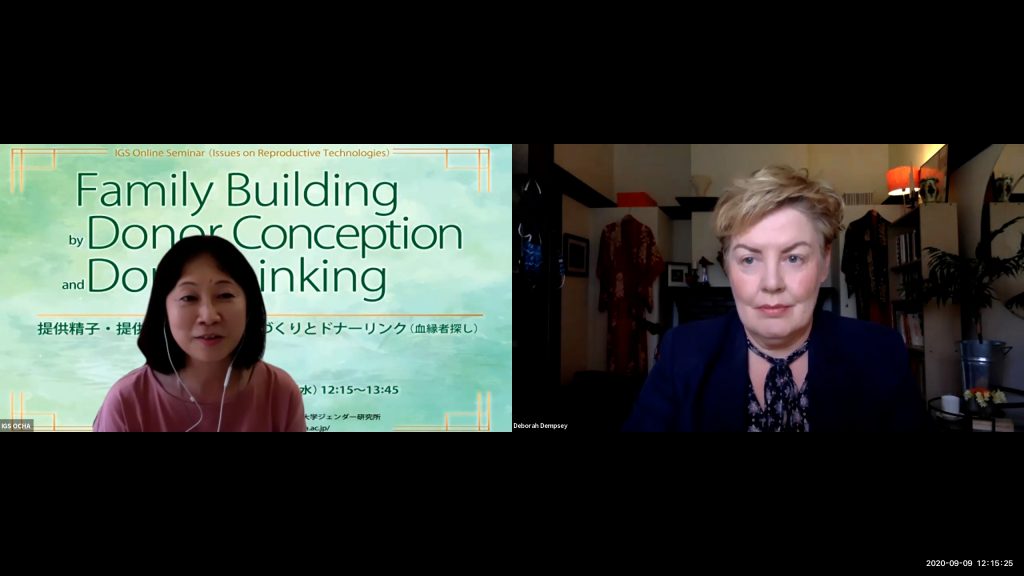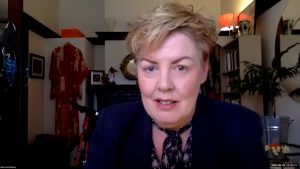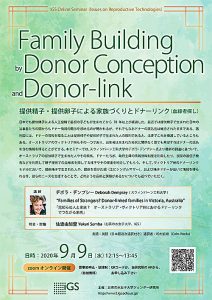【International IGS Seminar】
Family Building by Donor Conception and Donor-linking
On September 9, 2020, we invited Dr. Deborah Dempsey from Swinburne University of Technology and held an IGS seminar on “Family Building by Donor Conception and Donor-linking.” She started by talking about the laws in Victoria and then introduced the research project that she is involved in: “Family of Strangers? Donor-linked Families.”

Some jurisdictions in the world have abolished gamete donor anonymity over the last several decades and have passed laws that secure donor-conceived people’s right to know gamete donors’ identifying information. The state of Victoria is one of them. It enforced the Assisted Reproductive Treatment Amendment Act 2016 in March 2017, making it possible for donor-conceived people to trace their gamete donors regardless of when the donation occurred in Victoria. In addition, donors can submit an application to find out information on the offspring born from their sperm in Victoria.
In Australia, there are at least two types of linking: statutory linking occurs through government-run registers, and nonstatutory linking is when people obtain information from clinics or through direct consumer genetic testing companies. The matches found are with donors, donor offspring, or half-siblings. The use of genetic testing has increased, and the results have successfully helped people find each other in Victoria. Dr. Dempsey has also researched the applications made to donor registers; what information donors, donorconceived people, and recipient parents want; and the reasons for submitting these applications through the research project. She and her colleagues received different responses from the donors, donor-conceived people, and recipient parents. The donor-conceived people tended to be more interested in the medical history than the other parties were, but in general, all parties were interested in information that would provide a
sense of the whole person, such as the donor’s personality, interests, hobbies, and likes and dislikes. Most of the information seekers also wanted to contact the parties involved, for example, an email exchange or future in-person meeting. Most of the recipient parents were single mothers, and they tended to want photos of the donor at different ages.
 Dr. Dempsey also talked about how fertility clinics participate in donor linking. She found that clinics were involved in various activities. Some clinics were open to making it easy for people to connect, and other clinics were more passive or reluctant and unwilling to outreach to other parties that were open to contact.
Dr. Dempsey also talked about how fertility clinics participate in donor linking. She found that clinics were involved in various activities. Some clinics were open to making it easy for people to connect, and other clinics were more passive or reluctant and unwilling to outreach to other parties that were open to contact.
Thus, the most relevant point is that linking from the perspective of clinics was really about individual staff members who are willing to take responsibility. Few clinics had policies on linking practices. Thus, she posited that donor-conceived people and their parents had different access to information and support,
depending on which clinic was used for conception. Last, she mentioned the donors whom they spoke to and who initiated applications. They had various reasons for applying, for example, mere curiosity and to know how many offspring were born because of their donation. Many of them wanted to know what their donor offspring looked like or were interested in what aptitudes and talents their donor offspring had. Per the Victoria law, donors can be informed of how many offspring their donation produced, but donor offspring cannot obtain their half-sibling’s information. Thus, there was a response that donors submitted applications because they wanted to contribute to the donor-conceived person’s research on their half-siblings.
In Japan, donor anonymity and donor offspring’s right to know are controversial topics. Many donorconceived people and recipient parents attended the seminar, and Dr. Dempsey answered their many questions.
Reported by Yukari SEMBA
Project Research Fellow, IGS, Ochanomizu University
|
《Event Details》 【Date/Time】September, 9, 2020, 12:15–13:45 (JST)/2:15–15:45 (AEDT) |


